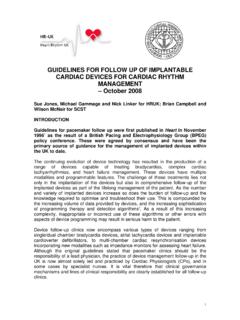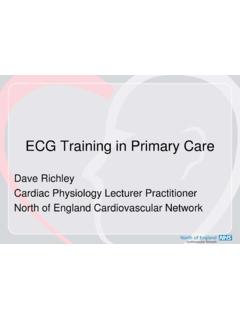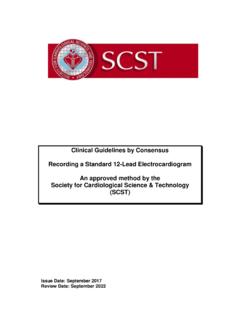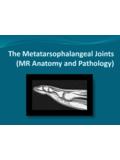Transcription of Certificate in Electrocardiography - SCST
1 SCST Certificate of Electrocardiography Syllabus 2010 v3 2014 Certificate in Electrocardiography The Certificate in Electrocardiography is awarded by the Society to candidates who satisfy the examiners of their clinical competence to record safely and accurately a 12-lead resting electrocardiogram, and on their understanding of the features which distinguish an abnormal from a normal electrocardiogram. The syllabus leading to the Certificate in Electrocardiography is designed to encourage accurate and efficient recording of the 12-lead resting electrocardiogram in accordance with safe and responsible working practices. The syllabus prescribes the following areas of supporting knowledge and understanding expected of the successful candidate: a) Medical and technical terminology applicable to the subject area.
2 B) Essential anatomy and physiology of the heart and circulation as relevant to Electrocardiography . c) The work and responsibilities of a support worker in cardiology. d) Problems encountered in the recording of a 12-lead resting electrocardiogram and their solutions. e) Features of the normal 12-lead resting electrocardiogram and the recognition of some common abnormalities. The syllabus is in three sections 1) anatomy and physiology of the heart and circulation. 2) Electrocardiography . 3) Interpretation of the electrocardiogram in health and disease. The examination paper is in two parts: Paper One anatomy and Physiology. Paper Two Electrocardiographic Instrumentation, Technique and Interpretation.
3 Paper Two contains an Essential ECG Interpretation Section This section will comprise of three 12-lead taken from the following list:- Complete heart block Left bundle branch block Right bundle branch block Ventricular fibrillation Atrial fibrillation Ventricular tachycardia Narrow complex tachycardia Acute ST elevation myocardial infarct Candidates will be required to identify which of these findings is demonstrated in each of the three ECGs. The questions are multiple choice, but it is essential to pass this section in order to successfully pass the whole paper. SCST Certificate of Electrocardiography Syllabus 2010 v3 2014 SYLLABUS anatomy and PHYSIOLOGY OF THE CARDIOVASCULAR SYSTEM: Knows the structure and function of the heart, the anatomy of the blood vessels and the roles of the different types of vessel in the circulatory system.
4 General structure and function of the heart, including: the role of the heart in the circulation valves and supporting apparatus chambers main coronary arteries and veins great veins and arteries pericardium Simple anatomy and function of the specialised conduction system: Sinus node Atrioventricular node Bundle of His Left and right bundle branches Purkinje fibres Pathology of the Cardiovascular System Understands common pathological terms used in the description of heart disease and, where applicable, associated electrocardiographic features. Knows the meaning of: Atherosclerosis; atheroma Ischaemia Angina pectoris, Unstable angina. Prinzmetal s angina ST-elevation and non-ST elevation myocardial infarction Acute coronary syndrome Heart failure Oedema necrosis Hypertension.
5 Atrial and ventricular septal defects. Cyanosis. Coarctation of the aorta. Valvular stenosis and regurgitation Pericarditis SCST Certificate of Electrocardiography Syllabus 2010 v3 2014 Electrocardiography : Instrumentation Understands instrumentation and the basic principles of lead theory needed for the effective and safe practice of Electrocardiography . Understands the function of the controls of the machine Paper speed Gain Filters Lead selector Manual/automatic operation Understands care of the equipment Care of recording paper Battery maintenance Care of leads and cables Understands electrodes Application of and connection to electrodes Care of electrodes Electrode positions Understands lead systems Unipolar and bipolar leads Einthoven's theory and its application.
6 Wilson's central terminal. Practical Electrocardiography Is able to record the electrocardiogram accurately from all types of patient Choice of appropriate leads for a particular patient category Setting of controls as appropriate for the specific recording to be undertaken Preparation of electrode sites to give optimum electrode contact and to minimise artefacts Connection of electrodes to patient Recording and follow-up Recording of a resting electrocardiogram from patients of all ages using both manual and automatic mode Recording of the resting electrocardiogram from a patient who: o is unconscious, o has language or communication difficulty, o is infectious or is in isolation, o has a physical disability (including amputation), o is visually impaired SCST Certificate of Electrocardiography Syllabus 2010 v3 2014 Evaluation of the recording to assess the need for re-recording, Re-recording as appropriate Recognition and elimination or reduction of artefacts Labelling of completed recordings as appropriate Cleaning, preparation and storage of equipment ready for subsequent recordings, including correct sterilisation and disposal procedures Electrode positions.
7 Correct application and positioning of limb and precordial electrodes, in accordance with the Society for Cardiological Science and Technology guidelines. Electrocardiographic interpretation: recognises the features of the electrocardiogram and makes appropriate measurements Relationship of the electrocardiogram to the electrical events of the heart. Relationship of the electrical events to the mechanical events of the cardiac cycle. Waveform components (P, Q, R, S, T and U) Definitions and normal ranges of PR interval and QRS duration Measurement of QT interval and calculation of corrected QT interval (QTc) by Bazett s formula Calculation of the heart rate from the electrocardiogram The appearance of the normal resting electrocardiogram Recognises the normal variations of the electrocardiogram in relation to: Age State of activity Body build Ethnic origin The normal electrocardiogram and common abnormalities Rhythms arising from the sinus node.
8 Normal sinus rhythm Sinus arrhythmia Sinus tachycardia Sinus bradycardia Sinus arrest Supraventricular tachyarrhythmias Atrial premature contractions (ectopics). Atrial tachycardia. Atrial flutter. Atrial fibrillation Supraventricular tachycardia Accelerated AV nodal (junctional rhythm) Conduction abnormalities Ventricular pre-excitation Left and right bundle branch block 1st degree AV block SCST Certificate of Electrocardiography Syllabus 2010 v3 2014 2nd degree AV block: Mobitz I (Wenckebach), Mobitz II and 2:1 block 3rd degree (complete) AV block Rhythms arising from the ventricles: Ventricular escape beats Ventricular premature beats (ectopics).
9 Ventricular tachycardia. Ventricular flutter. Ventricular fibrillation. Ventricular standstill (asystole) The electrocardiogram associated with an artificial cardiac pacemaker. Identification of pacemaker stimulus on the electrocardiogram Differentiation between atrial and ventricular pacing Interpretation of changes in the electrocardiogram arising from abnormal cardiac conditions Myocardial ischaemia Myocardial infarction Left ventricular hypertrophy Pericarditis Dextrocardia








